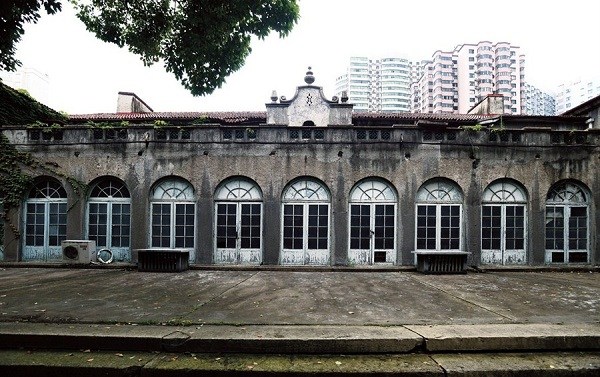
The Columbia Country Club used to be a place of recreation for American families from 1927 to 1942.(Zhang Xuefei)
American Club
Address: 209 Fuzhou Rd
In 1922 the premier all-male American Club bought a site on Fuzhou Road to build a new branch. It was completed in 1924. In its heyday, the American Club was one of the top clubs for expatriates living in Shanghai. The other two were the Shanghai Club (for British expats) at No. 2 on the Bund and the French Club (originally on Yandang Road, but later in the building which is now the Okura Garden Hotel Shanghai).
Covering 916 square meters, the seven-story building (including an underground floor) was designed with a steel-and-concrete structure.
Equipped with advanced facilities for its time, the club provided almost everything that a gentleman needed, including a bowling room, a gym, a Turkish bath, and a bar. There were also rooms for billiards, mahjong, playing cards and reading.
On the third, fourth and fifth floors were 50 bedrooms. A meeting room and banquet room were built on the sixth floor. There was even a rooftop garden overlooking the Huangpu River.
"Architect Laszlo Hudec chose the American Georgian colonial style, which was popular with social clubs in the US at that time," says Tongji University associate professor Hua Xiahong, author of the book "Shanghai Hudec Architecture."
"The interior is designed ... with a lot of dark wood, classic applied columns and white door frames. It is not widely known, but the mahjong room on the second floor came from the hand of a Chinese expert, who adapted the typical Chinese official style," Hua adds. "The room has a Chinese-style coffered ceiling with colorful paintings and palace lanterns as ornaments. It is furnished with traditional Chinese square tables and fauteuils to enhance the Chinese ambience."
The American Club became the offices of the Shanghai High People's Court and the Shanghai Second Intermediate People's Court after 1949. Since the two courts moved to Hongqiao Road in 1991, the building has been empty.
In June 2008, an exhibition about Hudec's work in Shanghai, co-hosted by the Shanghai Urban Planning Bureau and the Hungarian Consulate General in Shanghai, was held on the top floor of the former American Club, one of Hudec's early masterpieces in Shanghai.
Columbia Country Club
Address: 1262 Yan'an Rd W.
The history of Columbia Country Club is a tale of opposites. From 1927 to 1942 it was a place where Americans came to socialize with one another and "escape" life in Shanghai. After the Pacific War broke out in 1941 and Japanese soldiers occupied the international settlements, it was used as a place to hold Western captives, some of whom were forced to sleep in the club's bowling alley.
Like the Community Church, the club was originally founded in 1918 on Route Doumer (today's Donghu Road), but as membership grew a bigger clubhouse was required. Eventually, an 8-acre site on the south side of Great Western Road (today's Yan'an Road W.) was acquired.
In 1923, China Weekly Review published a sketch of the building by American architect Elliot Hazzard, who had designed signature buildings like the Foreign YMCA Building near People's Square and Wing On Tower on Nanjing Road.
Hazzard created a two-story clubhouse with arched windows, a tiled roof and twisting columns. It featured a dining room, a ball room, a billiard room and facilities for swimming, bowling, baseball, tennis and squash.
After the club's completion in 1927, American families living nearby often went there for recreation.
But the happy times vanished once the Pacific War erupted and allied nationals in China were interned by the Japanese. The Columbia Country Club was used as a transit camp beginning in 1942 and became an internment camp in May 1943.
The club building remains well-preserved and is undergoing a renovation funded by property developers Wanke, which plans to turn it into part of a creative office compound.


















































